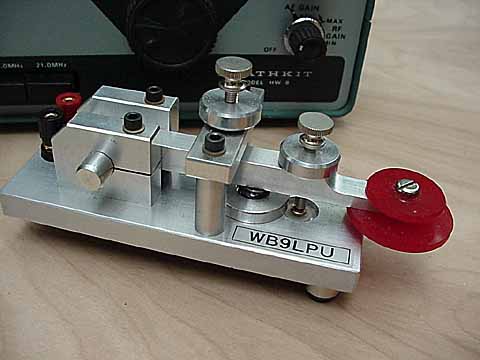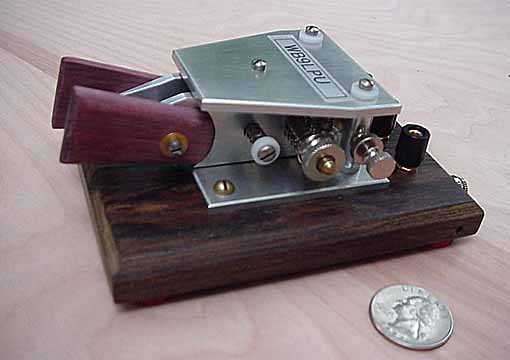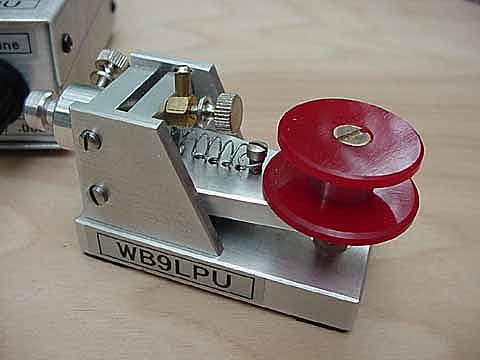50 ''Fancy'' Brass Straight Key:(28KB)
This is my first attempt at a ''fancy'' brass straight key. It is very
heavy, made of solid brass and mounted on a bocate wood base. It has a ball-
bearing movement, and travel and force adjustments share the same vertical
shaft. All of the parts of the key are mounted on a brass baseplate which is
then mounted on the wooden base.

60 ''Fancy'' Brass Straight Key:(32KB)
This is my second attempt at a fancy straight key. Solid brass construction,
with bubinga wood base and knob. The lever is pivoted on conventional ball
bearings mounted in the bearing supports. Side-play is kept to a minimum by
careful machining and assembly. Contacts are also made of brass and the
lever rest position, contact spacing, and lever force are all separately
adjustable and lockable. Very good ''feel''. I use this key daily.

70 The Prototype Ball-Bearing Straight Key:(24KB)
This is my first straight key. It is a ball-bearing design, made
entirely of aluminum. The �upper screws set the limits of travel, while the
wheel below the lever sets the force. The unit has a good ''feel''.

80 Miniature Ball-Bearing Magnetic Repulsion Straight Key:(22KB)
This miniature straight key is of conventional design with ball bearing
pivots. The return force is provided by a pair of rare-earth magnets working
in the repulsion mode. Operating force is adjusted by sliding the lower
magnet away from the common axis. The knurled knob in the cneter is for
locking the magnet slide in place, and key travel is set by the knob in front.
The key is machined from aluminum allow, with stainless steel and brass
fittings. While small in size, the key is very solid and feels like a much
larger unit. It is my best effort at a QRP straight key.

80b Another view of this key:(16KB)

90 Miniature QRP Straight Key:(16KB)
This is the first attempt at a small ''QRP'' key using a non-conventional
pivot mechanism. Instead of pivot points or bearings, the key lever is
connected to the base through a piece of very thin shim stock. This
connection does not contribute to the operating force but it eliminates lost
motion and side play. The force is provided by a compression spring
compressed by the large knob on top, and the wheel below the red knob is used
to adjust the travel distance. The ''feel'' of the key is somewhat different
from a conventional key, but it has been used on the air with good success.
The shim stock connection has shown no sign of fatigue and it is easily
replaceable. All aluminum construction, nice ''feel''.

Non-Iambic Paddles:
100 Non-Iambic Rocker-Plate Paddle:(27KB)
This is my first attempt. It uses a rocker-plate mechanism. There is some
lost motion, and the ''feel'' is not crisp. Construction is all aluminum,
with some plated brass fittings.

110 Non-Iambic Rocker-Plate Paddle:(22KB)
This is my second attempt. The movement uses a shim-stock hinge and a
lateral rocker-plate approach. It works well, but the ''feel'' is not yet
there.

120 Non-Iambic Ball-Pivot Paddle:(22KB)
This is the first of several small paddles to use the ball-pivot design and
it is the only non-iambic one. It uses a transverse ''rocker'' mechanism. The
paddle lever forms a t-type arrangement with a four-ball pivot unit at right
angles to it, so that moving the lever results in a rocking motion of the
pivot unit. (this was worked out in an earlier and larger version, without
the ball pivots.) A single tension spring at the center of the pivot unit
provides the restoring force. This design solves a difficult problem in non-
iambic paddle design - it is not easy to get a definite-feeling center
position that is bounce-free and positive. Two finger pieces are provided to
give the unit a better ''feel''. This design is further elaborated in later
attempts. It works adequately but the movement lacks vertical stability. It
has rather nice ''feel''.

Iambic Paddles:
150 Large Ball-Pivot Iambic Paddle:(21KB)
This is my first attempt at a large ball-pivot iambic paddle. This large
iambic paddle set is mounted on a base made of a tropical wood known as
purpleheart. The paddles are made from the same wood. The top plate is made
of brass, while most of the mechanism is of aluminum. The pivot balls are of
brass and are lighly lubricated. Tension for each paddle is independently set
with the thumbscrews on either side, and contact spacing is set by another
pair of thumbscrews. The rest positions of the paddles are set by a large
thumbscrew at the rear of the unit which changes the spacing of two captive
steel balls against which the sides of the paddle bars rest. This setting
interacts with the contact spacing adjustment which must be re-set if the
paddle spacing is changed. It is very massive and works quite well.

150d Design Drawing of this key:(29KB)

160 Ball-Pivot Iambic Paddle:(27KB)
This all aluminum iambic paddle set (with ball-pivot mechanism) uses separate
tension springs to set the paddle force for ''dit'' and ''dah''. Tension is
adjusted by pulling out the spring-holding cylinder to the desired degree, and
locking it with the thumbscrew. Paddle travel is set for each side with
thumbscrews near the paddles. The two arm-stabilizers prevent rough handling
from dislodging the mechanism. This unit uses lubricated brass pivot balls
which are held captive by the top and bottom plates. Even though the unit is
made of aluminum, it is sufficiently heavy to be used without chasing it all
over the desk, especially when it is used with the stabilizer arms, which are
pivoted so that all four feet may be planted firmly. A nice-working unit with
a good, crisp ''feel''.

160d Design Drawing of this key:(25KB)

170 Small Ball-Pivot Iambic Paddle:(28KB)
Small ball-pivot iambic paddle which uses 3/16-inch Delrin balls. Finger
piece position is adjustable. Mounted on cocobolo wood base with fingerpieces
of same. This is my favorite of the ball-pivot iambics and it is also
on my QSL card. Made of brass and aluminum.

180 Small Ball-Pivot Iambic Paddle:(20KB)
Very similar to above design. All aluminum, bocate wood base, purple heart
fingerpieces. Stable and smooth-working.

190 Miniature Ball-Bearing Magnetic Repulsion
Iambic Paddle:(25KB)
This is the first iambic/ball-bearing movement paddle. This miniature paddle
was built to fit in a 35-mm slide box. It is a ball-bearing unit that has
several interesting design features. The bearings are at the forward end of
the levers and they are pre-loaded by a small compression spring that runs
between them. (This also provides a DC return path for the switching action.)
Such an arrangement reduces the amount of play felt in the bearings.
Restoring force is provided by four rare-earth magnnets (two per side)
operating in the repulsion mode. Using the magnets in this way eliminates the
''clicky'' feel that some magnetic keys have (and that some people like).
Variations in force are provided by mounting the paddle magnets in a moveable
carrier on each paddle so that they can be moved out of line with the
stationary magnets. Distance of travel is limited by eccentric cylinderical
stops beside each paddle. Fold out legs give the key stability when in use.
Nice ''feel'' for such a tiny key.

200 Miniature Ball-Bearing Magnetic Repulsion
Iambic Paddle:(23KB)
This is a refinement on number 190 above. The eccentric travel stops have
been replaced with a locking screw mechanism that is easier to adjust. The
fold-out legs give it a somewhat wider stance than its predecessar. Details
of the magnet adjustment can be seen on the inner surface of the paddle
levers. The magnets are on the between-paddle levers and on the vertical
member between them. Adjusting the alignment of the magnets adjusts the
force.

200b Another view of this key:(18KB)

The 2001 Bugs:
300 This is a very unique design which used
magnetic repulsion instead of springs:(41KB)

310 This is a bug which is similar to number 300 above
but it is mounted on a wooden base:(42KB)

400 This is a right-angle bug which uses magnetic
repulsion instead of springs:(44KB)

The Amazing 2003 Fully Automatic Bug:
500 The 2003 Fully Automatic Key and it's Offspring:(77KB)
This is an amazing fully automatic bug capable of making both dots AND dashes
automatically. Many people have tried to design a fully automatic bug but
only a few have succeeded and none have used magnetic technology. Richard
Meis has done a great job of designing this bug. After 5 less successful
designs, he completed this magnetic, dual lever, dual over-and-under pendulum
bug. He intends to refine his design and perhaps try other automatic bugs in
the future.

550 The DOUBLEBUG VIII Fully-Autmatic Key:
This is a very much improved and simplified Fully Automatic key that uses
magnetic technology in a vey innovative way. You can read more about this
key in
Richard's website:
http://bugsbylpu.googlepages.com/home2

The Amazing 2005 RotoBug:
700 The RotoBug:(123KB)
This is an amazing and complex key. It is a totally new approach to the
design of a semi-automatic key that employs the rotation of a variable mass to
provide the power for the string of automatic dots. The design considerations
are so numerous that to fully understand its evolution and construction, you
need to read Richard's descriptive paper. This paper and those for all of his
other keys will be included in the next (2006) edition of Tom Perera's:
Telegraph Collectors Reference CD. Ordering details are given at the top of
this webpage: http://w1tp.com

The Amazing 2007 FULLY-AUTOMATIC RotoBug:
705 The 2007 Fully-Automatic RotoBug:
This is certianly the most amazing and complex of Richard's keys. It is a
totally new approach to the design of a fully-automatic key that employs the
rotation of a variable mass to provide the power for the string of automatic
dots and the rotation of another variable mass to provide the power for a
string of dashes.
The design considerations are so numerous that to fully understand its
evolution and construction, you will need to read Richard's descriptive paper
which he will make available when it is completed.

rm_706r1 Another view of the Fully-Automatic Roto-Bug:

rm_713r1 A view of the internal construction of the Fully-Automatic Roto-
Bug:

For more information contact:
RICHARD A. MEISS - WB9LPU
2626 Parkwood Drive.
Speedway, IN 46224
- email: (Please eliminate the SPACES when you type this email:)
igeq100 @ iupui.edu
 The lever force is provided by a compression spring
that pushes the lever against a fixed plate. The lever pivots with respect to
the fixed support on two precision balls that fit into milled pockets at
each side of the lever. The balls can be of brass, nylon, teflon,
delrin, etc. The ball pivot holds the lever in alignment while it moves, and
the lever force is provided by a compression (or tension) spring. The spring
force also holds the pieces together when the lever is at rest. In my
experience so far, the ball pivot provides adequate stability and a crisp and
smoother ''feel''. This basic mechanism can be used either in straight keys
or single and double paddles. Some of my recent designs use miniature ball
bearings rather than the ball pivot, and some use magnetic repulsion instead
of springs. All of the key designs shown here have been used successfully on
the air. None of the designs have been optimized for high speed keying because
I am still in the 15-18 wpm range. As I get faster, so will the paddles.
The lever force is provided by a compression spring
that pushes the lever against a fixed plate. The lever pivots with respect to
the fixed support on two precision balls that fit into milled pockets at
each side of the lever. The balls can be of brass, nylon, teflon,
delrin, etc. The ball pivot holds the lever in alignment while it moves, and
the lever force is provided by a compression (or tension) spring. The spring
force also holds the pieces together when the lever is at rest. In my
experience so far, the ball pivot provides adequate stability and a crisp and
smoother ''feel''. This basic mechanism can be used either in straight keys
or single and double paddles. Some of my recent designs use miniature ball
bearings rather than the ball pivot, and some use magnetic repulsion instead
of springs. All of the key designs shown here have been used successfully on
the air. None of the designs have been optimized for high speed keying because
I am still in the 15-18 wpm range. As I get faster, so will the paddles.
































